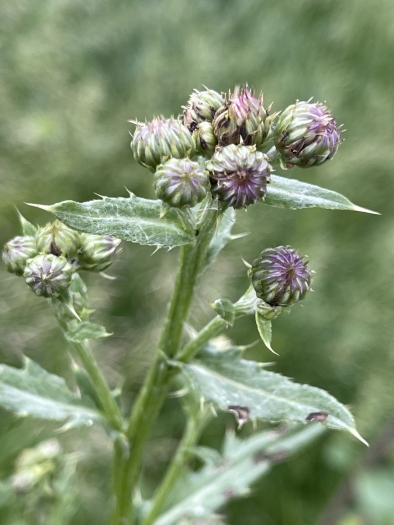Creeping Thistle
(Cirsium arvense)
Creeping Thistle (Cirsium arvense)
/
/

© Christine Laney
CC BY 4.0
Image By:
© Christine Laney
Recorded By:
Copyright:
CC BY 4.0
Copyright Notice:
Photo by: © Christine Laney | License Type: CC BY 4.0 | License URL: http://creativecommons.org/licenses/by/4.0/ | Uploader: gilawild | Publisher: iNaturalist |



















Estimated Native Range
Summary
Cirsium arvense, commonly known as creeping thistle, is a perennial herbaceous plant that is native to temperate regions of Europe, Asia, and northern Africa. It is often found in a variety of habitats including open woodlands, forest edges, fields, pastures, and disturbed sites. Creeping thistle prefers well-drained soils and can tolerate a range of sunlight conditions, from full sun to partial shade. It typically grows to a height of up to 59 inches and is known for its extensive clonal colonies formed through its root system.
Creeping thistle has spiny, lobed leaves and produces showy pink-purple flowers from June to August, which are highly attractive to pollinators such as bees and hoverflies. Its seeds are equipped with a pappus that aids in wind dispersal and can remain viable in the soil for up to 20 years, contributing to its invasive potential. While it is considered a weed in many regions, creeping thistle can be used for medicinal purposes, such as a diuretic or astringent, and has been used in traditional medicine. In cultivation, it is generally avoided due to its invasive nature and potential to outcompete native vegetation. Control measures include mechanical removal, herbicides, and biological agents like the weevil Larinus planus. It is important to consider the invasiveness of Cirsium arvense before planting, as it can be extremely invasive outside its native range.CC BY-SA 4.0
Creeping thistle has spiny, lobed leaves and produces showy pink-purple flowers from June to August, which are highly attractive to pollinators such as bees and hoverflies. Its seeds are equipped with a pappus that aids in wind dispersal and can remain viable in the soil for up to 20 years, contributing to its invasive potential. While it is considered a weed in many regions, creeping thistle can be used for medicinal purposes, such as a diuretic or astringent, and has been used in traditional medicine. In cultivation, it is generally avoided due to its invasive nature and potential to outcompete native vegetation. Control measures include mechanical removal, herbicides, and biological agents like the weevil Larinus planus. It is important to consider the invasiveness of Cirsium arvense before planting, as it can be extremely invasive outside its native range.CC BY-SA 4.0
Plant Description
- Plant Type: Herb
- Height: 1-4 feet
- Width: 1-2 feet
- Growth Rate: Rapid
- Flower Color: Pink, Purple
- Flowering Season: Spring, Summer
- Leaf Retention: Semi-deciduous
Growth Requirements
- Sun: Full Sun
- Water: Medium
- Drainage: Fast, Medium, Slow
Common Uses
Erosion Control
Natural Habitat
Native to temperate regions of Europe, Asia, and northern Africa, often found in open woodlands, forest edges, fields, pastures, and disturbed sites
Other Names
Common Names: Creeping Thistle, Field Thistle, California Thistle, Californian Thistle, Canada Thistle
Scientific Names: , Cirsium arvense, Aplotaxis circioides, Aplotaxis pungens, Breea arvensis, Breea dioica, Breea ochrolepidea, Breea ochrolepidia, Breea praealta, Breea setosa
GBIF Accepted Name: